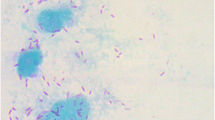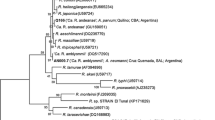Abstract
The aim of this study was to determine the infection with Rickettsiales in ticks and birds from the main protected urban area of Buenos Aires City (Argentina). One Amblyomma aureolatum (0.2%) and one Ixodes auritulus (0.1%) were positive by PCR targeting Rickettsia 23S-5S rRNA intergenic spacer. Phylogenetic analysis shows to findings in A. aureolatum are closely to Rickettsia bellii and for I. auritulus are related to ‘Candidatus Rickettsia mendelii’. One I. auritulus (0.1%) and three A. aureolatum (0.6%) were positive by PCR for a fragment of the 16S rRNA gene of the Anaplasmataceae family. The sequences obtained from A. aureolatum were phylogenetically related to Midichloriaceae endosymbionts. The sequence from I. auritulus s.l. had 100% identity with Ehrlichia sp. Magellanica from Chile and two genotypes of Ehrlichia sp. from Uruguay. The results of our study show that Rickettsia and Ehrlichia are present in ticks in the main protected urban area of Buenos Aires City.


Similar content being viewed by others
References
Aguiar DR, Cavalcante GT, Pinter A et al (2007) Prevalence of Ehrlichia canis (Rickettsiales: Anaplasmataceae) in dogs and Rhipicephalus sanguineus (Acari: Ixodidae) ticks from Brazil. J Med Entomol 44:126–132. https://doi.org/10.1603/0022-2585(2007)44[126:poecra]2.0.co;2
Akl T, Bourgoin G, Souq ML et al (2019) Detection of tick-borne pathogens in questing Ixodes ricinus in the French Pyrenees and first identification of Rickettsia monacensis in France. Parasite. https://doi.org/10.1051/parasite/2019019
Almeida AP, Souza TD, Marcili A, Labruna MB (2013) Novel Ehrlichia and Hepatozoon agents infecting the crab-eating fox (Cerdocyon thous) in southeastern Brazil. J Med Entomol 50:640–646. https://doi.org/10.1603/ME12272
Andoh M, Sakata A, Takano A et al (2015) Detection of Rickettsia and Ehrlichia spp. in ticks associated with exotic reptiles and amphibians imported into Japan. PLoS ONE 10:e133700. https://doi.org/10.1371/journal.pone.0133700
Arrais RC, Paula RC, Martins TF et al (2021) Survey of ticks and tick-borne agents in maned wolves (Chrysocyon brachyurus) from a natural landscape in Brazil. Ticks Tick Borne Dis 12:101639. https://doi.org/10.1016/j.ttbdis.2020.101639
Berthová L, Slobodník V, Slobodník R et al (2015) The natural infection of birds and ticks feeding on birds with Rickettsia spp. and Coxiella burnetii in Slovakia. Exp Appl Acarol 68:299–314. https://doi.org/10.1007/s10493-015-9975-3
Blanco CM, Teixeira BR, da Silva AG et al (2016) Microorganisms in ticks (Acari: Ixodidae) collected on marsupials and rodents from Santa Catarina, Paraná and Mato Grosso do Sul states, Brazil. Ticks Tick Borne Dis 8:90–98. https://doi.org/10.1016/j.ttbdis.2016.10.003
Cicuttin GL, De Salvo MN, Siccardi FM et al (2015) Caninos domésticos con elevada infestación por garrapatas y patógenos bacterianos asociados en la Ciudad Autónoma de Buenos Aires. Rev Argentina Zoonosis y Enfermedades Infecc Emergentes X:13–16
Cicuttin GL, De Salvo MN, Gury Dohmen FE (2016) Molecular characterization of Ehrlichia canis infecting dogs, Buenos Aires. Ticks Tick Borne Dis 7:954–957. https://doi.org/10.1016/j.ttbdis.2016.04.017
Cicuttin GL, De Salvo MN, Nava S (2017) Especies de garrapatas duras en un área urbana protegida de la Ciudad Autónoma de Buenos Aires. Rev Argent Salud Pública 8:7–12
Cicuttin GL, De Salvo MN, Venzal JM, Nava S (2019) Borrelia spp. in ticks and birds from a protected urban area in Buenos Aires city, Argentina. Ticks Tick Borne Dis 10:101282. https://doi.org/10.1016/j.ttbdis.2019.101282
Cumbie AN, Walters EL, Gaff HD, Hynes WL (2020) First report of Candidatus Rickettsia mendelii in Ixodes brunneus from the United States. Ticks Tick Borne Dis 11:101309. https://doi.org/10.1016/j.ttbdis.2019.101309.First
Dumler JS, Barbet AF, Bekker CP et al (2001) Reorganization of genera in the families Rickettsiaceae and Anaplasmataceae in the order Rickettsiales: unification of some species of Ehrlichia with Anaplasma, Cowdria with Ehrlichia and Ehrlichia with Neorickettsia, descriptions of six new species combi. Int J Syst Evol Microbiol 51:2145–2165. https://doi.org/10.1099/00207713-51-6-2145
Félix ML, Muñoz-Leal S, Carvalho LA et al (2021) Molecular characterization of novel Ehrlichia genotypes in Ixodes auritulus from Uruguay. Curr Res Parasitol Vector-Borne Dis 1:100022. https://doi.org/10.1016/j.crpvbd.2021.100022
Flores FS, Costa FB, Nava S et al (2016) Rickettsial infection in ticks infesting wild birds from two eco-regions of Argentina. Braz J Vet Parasitol 25:378–382. https://doi.org/10.1590/S1984-29612016045
García-García JC, Portillo A, Núñez MJ et al (2010) A patient from Argentina infected with Rickettsia massiliae. Am J Trop Med Hyg 82:691–692. https://doi.org/10.4269/ajtmh.2010.09-0662
Guglielmone AA, Petney TN, Robbins RG (2020) Ixodidae (Acari: Ixodoidea): Descriptions and redescriptions of all known species from 1758 to December 31, 2019. Zootaxa 4871 https://doi.org/10.11646/zootaxa.4871.1.1
Hajduskova E, Literak I, Papousek I et al (2016) “Candidatus Rickettsia mendelii”, a novel basal group rickettsia detected in Ixodes ricinus ticks in the Czech Republic. Ticks Tick Borne Dis 7:482–486. https://doi.org/10.1016/j.ttbdis.2016.02.004
Hall TA (1999) BioEdit: a user friendly biological sequence alignment editor and analysis program for Windows 95/98/NT. Nucl Acids Symp Ser 41:95–98
Hornok S, Kováts D, Csörgő T et al (2014) Birds as potential reservoirs of tick-borne pathogens: first evidence of bacteraemia with Rickettsia helvetica. Parasit Vectors 7:128. https://doi.org/10.1186/1756-3305-7-128
Jado I, Escudero R, Gil H et al (2006) Molecular method for identification of Rickettsia species in clinical and environmental samples. J Clin Microbiol 44:4572–4576. https://doi.org/10.1128/JCM.01227-06
Krawczak FS, Labruna MB, Hecht JA et al (2018) Genotypic characterization of Rickettsia bellii reveals distinct lineages in the United States and South America. Biomed Res Int. https://doi.org/10.1155/2018/8505483
Labruna MB, Whitworth T, Horta MC et al (2004) Rickettsia species infecting Amblyomma cooperi ticks from an area in the State of Sao Paulo, Brazil, where Brazilian Spotted Fever is endemic. J Clin Microbiol 42:90–98. https://doi.org/10.1128/JCM.42.1.90
LaDeau SL, Allan BF, Leisnham PT, Levy MZ (2016) The ecological foundations of transmission potential and vector- borne disease in urban landscapes. Funct Ecol 10:560–574. https://doi.org/10.1056/NEJMra1300109.Origins
Liz JS, Anderes L, Sumner JW et al (2000) PCR detection of granulocytic ehrlichiae in Ixodes ricinus ticks and wild small mammals in western Switzerland. J Clin Microbiol 38:1002–1007. https://doi.org/10.1128/JCM.38.3.1002-1007.2000
Machado RZ, André MR, Werther K et al (2012) Migratory and carnivorous birds in Brazil: reservoirs for Anaplasma and Ehrlichia species? Vector-Borne Zoonotic Dis 12:705–708. https://doi.org/10.1089/vbz.2011.0803
Merhej V, Raoult D (2011) Rickettsial evolution in the light of comparative genomics. Biol Rev Camb Philos Soc 86:379–405. https://doi.org/10.1111/j.1469-185X.2010.00151.x
Merhej V, Angelakis E, Socolovschi C, Raoult D (2014) Genotyping, evolution and epidemiological findings of Rickettsia species. Infect Genet Evol 25:122–137. https://doi.org/10.1016/j.meegid.2014.03.014
Montagna M, Sassera D, Epis S et al (2013) “Candidatus Midichloriaceae” fam. Nov. (Rickettsiales), an ecologically: widespread clade of intracellular alphaproteobacteria. Appl Environ Microbiol 79:3241–3248. https://doi.org/10.1128/AEM.03971-12
Muñoz-Leal S, Clemes YS, Lopes MG et al (2019) Novel Ehrlichia sp. detected in Magellanic penguins (Sphenicus magellanicus) and in the seabird tick Ixodes uriae from Magdalena Island, southern Chile. Ticks Tick Borne Dis 10:101256. https://doi.org/10.1016/j.ttbdis.2019.06.015
Nava S, Elshenawy Y, Eremeeva M et al (2008) Rickettsia parkeri in Argentina. Emerg Infect Dis 14:1894–1897. https://doi.org/10.3201/eid1412.080860
Parola P, Roux V, Camicas J et al (2000) Detection of ehrlichiae in African ticks by polymerase chain reaction. Trans R Soc Trop Med Hyg 94:707–709. https://doi.org/10.1016/S0035-9203(00)90243-8
Parola P, Cornet J, Ose Y et al (2003) Detection of Ehrlichia spp., Anaplasma spp., Rickettsia spp., and other eubacteria in ticks from the Thai-Myanmar border and Vietnam. J Clin Microbiol 41:1600–1608. https://doi.org/10.1128/JCM.41.4.1600
Pinter A, Labruna MB (2006) Isolation of Rickettsia rickettsii and Rickettsia bellii in cell culture from the tick Amblyomma aureolatum in Brazil. Ann N Y Acad Sci 1078:523–529. https://doi.org/10.1196/annals.1374.103
Pritt BS, Allerdice MEJ, Sloan LM et al (2017) Proposal to reclassify Ehrlichia muris as Ehrlichia muris subsp. muris subsp. nov. and description of Ehrlichia muris subsp. eauclairensis subsp. nov., a newly recognized tick-borne pathogen of humans. Int J Syst Evol Microbiol 67:2121–2126. https://doi.org/10.1099/ijsem.0.001896
Romer Y, Seijo AC, Crudo F et al (2011) Rickettsia parkeri Rickettsiosis, Argentina. Emerg Infect Dis 17:1169–1173. https://doi.org/10.3201/eid1707.101857
Romer Y, Nava S, Govedic F et al (2014) Rickettsia parkeri rickettsiosis in different ecological regions of Argentina and its association with Amblyomma tigrinum as a potential vector. Am J Trop Med Hyg 91:1156–1160. https://doi.org/10.4269/ajtmh.14-0334
Sacchi ABV, André MR, Calchi AC et al (2021) Molecular and serological detection of arthropod-borne pathogens in carnivorous birds from Brazil. Vet Parasitol Reg Stud Re 23:100539. https://doi.org/10.1016/j.vprsr.2021.100539
Saracho-Bottero MNS, Beati L, Venzal JM et al (2021) Ixodes silvanus n. sp. (Acari: Ixodidae), a new member of the subgenus Trichotoixodes Reznik, 1961 from northwestern Argentina. Ticks Tick Borne Dis 12:101572. https://doi.org/10.1016/j.ttbdis.2020.101572
Sebastian PS, Tarragona EL, Saracho-Bottero MNS et al (2016) Bacteria of the genera Ehrlichia and Rickettsia in ticks of the family Ixodidae with medical importance in Argentina. Exp Appl Acarol 71:87–96. https://doi.org/10.1007/s10493-016-0096-4
Sebastian PS, Flores FS, Saracho-Bottero MN et al (2020) Molecular detection of rickettsial bacteria in ticks of the genus Ixodes from the Southern Cone of America. Acta Trop. https://doi.org/10.1016/j.actatropica.2020.105588
Sonenshine DE, Roe M (2014) Biology of ticks. Oxford University Press, Oxford
Szokoli F, Sabaneyeva E, Castelli M et al (2016) “Candidatus Fokinia solitaria”, a novel “stand-Alone” symbiotic lineage of Midichloriaceae (Rickettsiales). PLoS ONE 11:e0145743. https://doi.org/10.1371/journal.pone.0145743
Taira M, Ando S, Kawabata H et al (2019) Isolation and molecular detection of Ehrlichia species from ticks in western, central, and eastern Japan. Ticks Tick Borne Dis 10:344–351. https://doi.org/10.1016/j.ttbdis.2018.11.010
Tamura K, Stecher G, Peterson D et al (2013) MEGA6: Molecular evolutionary genetics analysis version 6.0. Mol Biol Evol 30:2725–2729. https://doi.org/10.1093/molbev/mst197
Thompson JD, Higgins D, Gibson TJ (1994) CLUSTALW: improving the sensitivity of progressive multiple sequence alignment through sequence weighting position-specific gap penalities andweight matrix choice. Nucleic Acids Res 22:4673–4680. https://doi.org/10.1093/nar/22.22.4673
Tokarz R, Tagliafierro T, Sameroff S et al (2019) Microbiome analysis of Ixodes scapularis ticks from New York and Connecticut. Ticks Tick Borne Dis 10:894–900. https://doi.org/10.1016/j.ttbdis.2019.04.011
Venzal JM, Estrada-Peña A, Portillo A et al (2008) Detection of alpha and gamma-proteobacteria in Amblyomma triste (Acari: Ixodidae) from Uruguay. Exp Appl Acarol 44:49–56. https://doi.org/10.1007/s10493-007-9126-6
Villalba-Apestegui P, Nava S, Brignone J et al (2018) Caso autóctono de fiebre manchada por Rickettsia parkeri en Ensenada, Buenos Aires. Med (Buenos Aires) 78:203–206
Wais de Badgen I (2013) La Reserva Ecológica Costanera Sur Patrimonio natural y cultural de la Ciudad de Buenos Aires. Agencia De Protección Ambiental (Ministerio De Ambiente y Espacio Público). Ciudad Autónoma de Buenos Aires
Acknowledgements
We gratefully acknowledge to Juan Carlos Sassarolli (Instituto de Zoonosis Luis Pasteur), Lorena Zapata (Reserva Ecológica Costanera Sur) and residents of Veterinary Public Health Residency (Instituto de Zoonosis Luis Pasteur). This work was partially supported by research fellowship ‘Ramón Carrillo-Arturo Oñativia’ 2015 (Ministry of Public Health, Argentina) and by grant for Clinical and Epidemiological Research 2016-2018 (Roemmers Fundation, Argentina). SN acknowledges the financial support of INTA, Asociación Cooperadora Inta Rafaela and CONICET.
Author information
Authors and Affiliations
Corresponding author
Ethics declarations
Conflict of interest
None.
Additional information
Publisher’s Note
Springer Nature remains neutral with regard to jurisdictional claims in published maps and institutional affiliations.
Supplementary Information
Below is the link to the electronic supplementary material.
Online Resource 1
Blood samples obtained by order, family, species and numbers of birds. Electronic supplementary file1 (PDF 185 kb)
Online Resource 2
Order, family, species and numbers of dead birds analyzed in this study. Electronic supplementary file2 (PDF 195 kb)
Rights and permissions
About this article
Cite this article
Cicuttin, G.L., De Salvo, M.N., Venzal, J.M. et al. Rickettsia spp., Ehrlichia sp. and Candidatus Midichloria sp. associated to ticks from a protected urban area in Buenos Aires City (Argentina). Exp Appl Acarol 86, 271–282 (2022). https://doi.org/10.1007/s10493-022-00684-0
Received:
Accepted:
Published:
Issue Date:
DOI: https://doi.org/10.1007/s10493-022-00684-0




